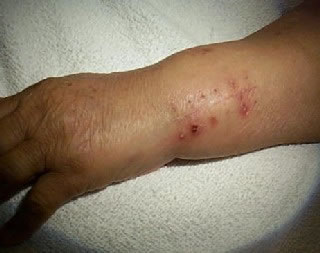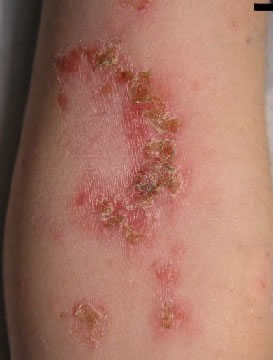Wound Infection
Is this your child’s symptom?
- Signs of wound infection include pus, spreading redness, increased pain or swelling, and fever
- A break in the skin (a wound) shows signs of infection
- Includes infected cuts, scrapes, sutured wounds, puncture wounds and animal bites
- Most dirty wounds become infected 24 to 72 hours later
Symptoms of Wound Infections
- Pus. Pus or cloudy fluid is draining from the wound.
- Pimple. A pimple or yellow crust has formed on the wound.
- Soft Scab. The scab has increased in size.
- Red Area. Increasing redness occurs around the wound.
- Red Streak. A red streak is spreading from the wound toward the heart.
- More Pain. The wound has become very tender.
- More Swelling. Pain or swelling is increasing 48 hours after the wound occurred.
- Swollen Node. The lymph node draining that area of skin may become large and tender.
- Fever. A fever occurs.
- The wound hasn’t healed within 10 days after the injury.
When to Call for Wound Infection
Call 911 Now
Call Doctor or Seek Care Now
|
Call Doctor Within 24 Hours
Call Doctor During Office Hours
|
Self Care at Home
|
Call 911 Now
- Not moving or too weak to stand
- You think your child has a life-threatening emergency
Call Doctor or Seek Care Now
- Fever occurs
- Red streak runs from the wound
- Spreading redness around the wound
- Severe pain in the wound
- Any face wound with signs of infection
- No past tetanus shots
- Your child looks or acts very sick
- You think your child needs to be seen, and the problem is urgent
Call Doctor Within 24 Hours
- Pus or cloudy drainage from the wound
- Wound gets more painful or tender after 2 days
- Last tetanus shot was more than 5 years ago
- You think your child needs to be seen, but the problem is not urgent
Call Doctor During Office Hours
- Pimple where a stitch (or staple) comes through the skin
- You have other questions or concerns
Self Care at Home
- Mild redness of wound
Care Advice for Mild Redness of Wound
-
What You Should Know About Normal Healing:
- Some pink or red skin on the edge of the wound is normal.
- It’s more common if the wound is sutured.
- It’s also normal for it to be swollen for a few days.
- Your child’s wound is not infected unless the redness spreads or pain increases.
- Here is some care advice that should help.
-
Warm Soaks or Warm Wet Cloth:
- For any redness or other signs of early infection, use heat.
- Open Cuts or Scrapes. Soak it in warm water. You can also put a warm wet cloth on the wound. Do this for 10 minutes 3 times per day. Use a warm saltwater solution. You can make your own. Put 2 teaspoons (10 mL) of table salt in a quart (liter) of warm water.
- Closed or Sutured Cuts. Put a heating pad on the wound. You can also use a warm, moist washcloth. Do this for 10 minutes 3 times per day.
- Cautions for Sutured Wounds. Do not put anything wet on the wound for first 24 hours. After 24 hours, can take brief showers. Never soak the wound before all sutures are removed.
-
Antibiotic Ointment:
- Use an antibiotic ointment (such as Polysporin).
- No prescription is needed.
- Put it on the wound 3 times a day.
- If the area could become dirty, cover with a bandage (such as Band-Aid).
-
Pain Medicine:
- To help with the pain, give an acetaminophen product (such as Tylenol).
- Another choice is an ibuprofen product (such as Advil).
- Use as needed.
-
Fever Medicine:
- For fevers above 102° F (39° C), give an acetaminophen product (such as Tylenol).
- Another choice is an ibuprofen product (such as Advil).
- Note: Fevers less than 102° F (39° C) are important for fighting infections.
- For all fevers: Keep your child well hydrated. Give lots of cold fluids.
-
What to Expect:
- Pain and swelling normally peak on day 2.
- Any redness should go away by day 4.
- Complete healing should occur by day 10.
-
Return to School:
- For true wound infections, your child can return after the fever is gone. Your child should also be taking an antibiotic by mouth for 24 hours.
- For minor redness around the wound, your child does not need to stay home.
-
Call Your Doctor If:
- Wound becomes more painful
- Redness starts to spread
- Pus or fever occurs
- You think your child needs to be seen
- Your child becomes worse
And remember, contact your doctor if your child develops any of the ‘Call Your Doctor’ symptoms.
Disclaimer: this health information is for educational purposes only. You, the reader, assume full responsibility for how you choose to use it.
Copyright 2000-2019 Schmitt Pediatric Guidelines LLC.




